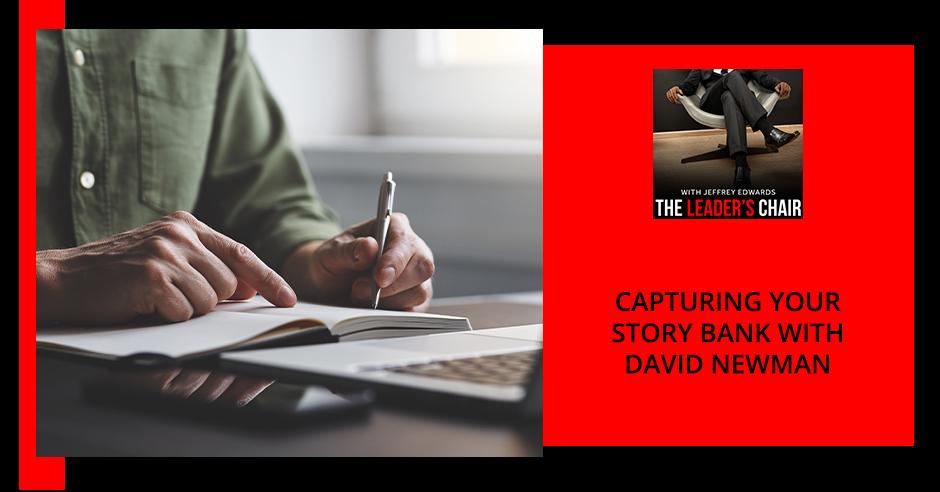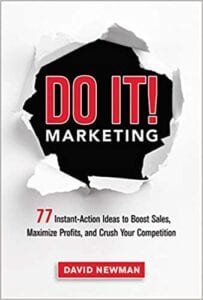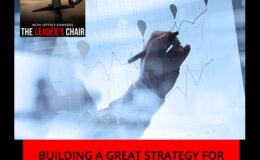
How do you hone your voice as a leader, and make your message crystal clear?
In this episode, I speak with David Newman, the Founder of Do It Marketing, who’s helped thousands of people move their business forward and find their voice. David shares why personal branding is essential to commercializing your expertise — and the steps needed to craft that brand, starting with your story bank.
About David Newman

The founder of Do It Marketing, David Newman is a member of the NSA Million Dollar Speakers Group. Sharing his expertise worldwide, he is also the author of the business bestsellers ‘Do It! Marketing‘ and ‘Do It! Speaking‘.
David is also the creator of the Expert Profit Formula mentoring program, where he helps thought leaders market their smarts and make a bigger dent in the universe.
Check out this episode if you want to learn:
- Why consistency is key to personal branding
- How to collect stories that influence others
- What it really takes to build company culture
🎧 Listen to the podcast here:
Capturing Your Story Bank With David Newman
You help people find their voice in a way that’s easy and informative. What is it that inspires you to do the work that you do, helping executives and entrepreneurs boost their impact?
Part of the inspiration comes from being so clueless about this myself early on. In my corporate career, I always thought that the work was about doing the work. It wasn’t necessarily about your influence, showing off, or all of these negative connotations around personal branding.
It’s not being braggadocious — it’s personal branding. You’re not hogging the spotlight as a leader. I was either clueless about it early on, or I was actively pushing it away, thinking that it (was) showy or braggy. Fast forward to when I launched my career, that attitude of saying, ‘Nothing to see here, move right along’ wasn’t serving me well for the first couple of years of my entrepreneurial journey.
'I need your help' is one of the most powerful leadership statements you are ever going to make. Share on XWhat is it about personal branding that can be so uncomfortable for people?
(I’ve) worked with lots and lots of consultants, executives and entrepreneurs, (and) this (discomfort) shows up in lots of ways. It shows up as imposter syndrome, that little voice in your head saying, ‘I don’t know if you’re good enough, if people want to pay you money.’ If you’re inside a corporate role, (it says) ‘I don’t know if you’re worthy of being praised, then promoted. Maybe you got a lucky break — you’re not the rock star C-Suite leader that you think you are.’
Only the most successful people have that little voice, because the idiots are full of self-confidence. They’re blowing through the world unobstructed by any of these thoughts. It’s always the conscientious, the thorough, the high–integrity, the high–intelligence, the high–capability people that have imposter syndrome.
My inspiration is to help those high–integrity, high–intelligence, high–skill people commercialize their expertise, and to make a bigger dent in the universe, to quote Steve Jobs.
It seems almost counterintuitive that they should be the ones struggling with personal branding.
It is totally counterintuitive. When we work with executives and entrepreneurs who (have) more of a humble leadership style, they say, ‘It’s not about me — it’s about the company, the team, brand, products and services.’
It’s like, yes, but let’s look at every mega-successful CEO. You can look at Steve Jobs, Jack Welch or any high-flying CEO like Elon Musk and Oprah Winfrey. You name the billionaire head of your favourite empire, (and) they do feel that it’s a little bit about them, their message, vision — shaping the universe to become what they want (it) to look like.
It sounds like, despite any reservations, you have to put yourself out there.

Do It! Marketing: 77 Instant-Action Ideas to Boost Sales, Maximize Profits, and Crush Your Competition
You have to have the self-awareness to understand that humility, by itself, is not going to close the deal. It’s a combination of leveraging your personal strengths, your personal message and your personality in the service of your company, your team, and the movement that your company is looking to lead.
Someone once said that if you don’t blow your own horn, there’s not a lot of music happening. You don’t want to blend in (or) be vanilla. The world is full of capable leaders, (but) it is not necessarily full of outstanding and remarkable leaders — people who are worth talking about. That’s what you need to become to stand out from all the noise.
What are some strategies you use to help leaders get there?
As far as capturing the actual thought leadership, I would advise folks to think about all of the mantras, philosophies and sound bites. For example, you have Jeffrey-isms that you’re famous for. I have David-isms that I’m famous for. When you’re looking at your clients, your team, your internal and external stakeholders, it’s almost like: what do people make fun of you for saying?
It’s like, ‘I know what Jeffrey is going to say (X), because he always says fill in the blank.’ That’s what I mean by those isms, principles, mantras, sound bites — little fortune cookie bits of wisdom.
One thing that every leader can do is start to collect those. Flip open a legal pad (or) your computer. What are the things that you’re internally famous for saying, for thinking? What are (your) go-to bits of advice when a team member comes to you?
OK, so I’ve got my sound bites — what then?
Use that as the springboard to start capturing a story bank. If you join Toastmasters, they tell you to start a journal or a story bank. Start collecting all of these life stories, incidents, anecdotes, things that have happened to you — whether they’re personal (or) professional — that you can use as a vehicle for teaching.
For example, I have a parallel parking story. When we first had kids back in the 1990s, I’d never owned a minivan. We bought this giant, behemoth Ford Windstar. It was the biggest minivan on the market at the time. I could never parallel park this thing — I would hit the car behind me, the car in front of me. The front wheels would hit the curb, the back wheels would hit the curb. I would turn around to the kids in their little car seats and I go, ‘Watch this!’, (and) show off how bad my parallel parking was.
The joke was that dad’s an excellent parallel parker. Eventually, because of practice and positive reinforcement, I kept getting better at it. I would stop hitting the car in front of me, I would stop hitting the car behind me. I would still hit the front tires against the curb, still hit the back tires against the curb — but then I would say, ‘See, excellent parallel parking job.’
Ah, I can picture it now!
I started taking pictures of how straight my parallel parking was, and (put) these in the presentations as I was telling the parallel parking story. The punch line is by the time I got done saying, ‘Kids, watch this — dad’s an excellent parallel parker’ — after doing enough damage to tires, hubcaps and other vehicles — I did become an excellent parallel parker.
Why? It’s practice and self-belief. Where can we apply those lessons? Let’s say that you’re the CEO of a company. There are 15 different ways you can use that parallel parking story as a metaphor for leadership, training, skills development and mentoring. These are the kinds of (stories) you see CEOs and leaders go out (with) on the speaking circuit, or (using in their) books.
What goes in the books? The Jeffrey-isms, the you-isms, the mantras, philosophies, stories, metaphors, analogies. It’s not just thought leadership — it is leadership.
How does that translate into leading a team?
Part of a leader’s responsibility is to capture what (their) company believes, what (the) manifesto is. That is made up from the top-down — from all of the executives singing from the same hymnal. That’s how you build a culture.
The best way to capture that is stories, practices, principles, philosophies, mantras. Make it digestible. That’s another part of the whole communication chain, telling your story and finding your voice: are you known for (the) clear, consistent communication of a certain set of principles?
'People get on board with leaders who are open, authentic, vulnerable, and honest.' Share on XSo consistency is key. Are there any other stories from your story bank that you like to tell?
When our kids were small, my son went to private school for one year, because there was nothing else available. It (was) an elite, suburban little private school.
We had a year of these parent–teacher conferences, meetings and assemblies. One day in the spring, the principal gets up, and it was a key leadership moment. He said, ‘You parents have been listening to me. As you know, my message doesn’t change.’ He (was) always talking about the amazing kids, the amazing parents, what a great job we’re doing, what a great job the teachers are doing, what a fantastic staff they have.
He says, ‘You’re not going to hear me say anything different, but you need to hear it anyway. Your kids are amazing. Your kids are fantastic. We have the best program. We have the best teachers.’
It’s about repetition.
‘What I say doesn’t change very much’: that was an anchor. He said it in a self-deprecating way, (but it’s) great because if the message changes every single time you open your mouth, people have no idea where you stand. They have no idea what you stand for, what you stand against.
Feel free to say, ‘My message doesn’t change all that much’ every time you open your mouth.
There also has to be a willingness to be vulnerable in sharing these kinds of moments. 44 of the Fortune 500 companies are your clients — IBM, Comcast, Microsoft, Accenture. What’s been your experience working with leaders from these organizations, where vulnerability can be seen as a liability?
One of my wife’s favourite sayings about me which is, ‘Frequently wrong, never in doubt.’ In my home life, I am extremely opinionated and stubborn. It’s the world according to David Newman.
As leaders, we need to be the opposite of that. The unpredictable nature of the business landscape is always going to slap you up and down the street. What builds trust and followership is saying, ‘I’m not 100% sure how this is going to play out. Here’s what we’re aiming for. I need your help.’
‘I need your help’ is one of the most powerful leadership statements you are ever going to make.

Story Bank: Humility by itself is not going to close the deal. It’s a combination of leveraging your strengths, message, and personality in the service of your company, team, and the movement that your company is looking to lead.
Why is that?
People get on board with leaders who are open, authentic, vulnerable and honest. They do not resonate with people who are frequently wrong, but never in doubt: ‘the boss said this was going to happen by Q2 and it didn’t happen.’ There are broken promises, delays, marketplace changes, and shifts in technology, regulations and compliance. We are not in control of the world. People tend to distrust leaders who say that they’re in control of the world when they’re not. That’s the extreme example — a megalomaniac, totalitarian leadership style that people tend to run away from.
This is different across all the generations. You look at the millennial generation, and it’s game over even before you start. They can smell that stuff a mile away. This is where you get the (feeling of) ‘us versus them’, (or) ‘I can’t imagine what the hell the leadership is talking about, they must be smoking their own exhaust.’
Leadership 101: you don’t want to foster the ‘us versus them’ mentality. When you start talking about ‘we’ instead of ‘me’, you start using statements like, ‘I need your help’. That is when you get everyone rowing in the same direction. You get rid of the ‘us versus them’, and you refocus back on the ‘we’.
What do you say to someone who’s questioning who they need to be, in order to advance in their career?
It was Tom Peters who said, ‘The culture walks out the door every night’, back when we were in offices. There is no culture — there are people that you’re working with and that you are leading. You start to change your behaviour, and the culture will start to change. There needs to be one person who makes the decision, ‘We are going to start to be more open, honest, vocal, vulnerable.’ It starts with one person — we need to lead by example.
'There is no culture. There are people that you're working with and leading.' Share on XIt’s like, ‘Everyone needs to be vulnerable, open and honest. You go first!’ No, you need to go first. Model the behaviour, and start to change the norms.
As you say, we need to lead by example.
This goes back to the old movie, ‘Jerry Maguire’, where all the sports agents are there. Suddenly, Jerry Maguire gets this moment of conscience and ethical integrity. He gets fired and immediately, he’s out on his own — but it didn’t have to go that way.
There are high–integrity leaders that introduce (culture shift) not with some crazy temper-tantrum in the middle of the office. (Instead), they gradually and sensibly start to introduce this kind of behaviour and communication change, which then leads to the culture change, where it becomes OK to be more vocal, more vulnerable, more communicative of your company’s mission.
Everyone then becomes a brand champion and advocate. That’s what you want. Sales doesn’t just happen in the sales department. The admin staff (can get) excited about the company’s products, services and future, (or) the accounting department. It is contagious once a few leaders start to pick up the reins, and start to behave in (a) new and different way.

Story Bank: The world is full of capable leaders. It is not necessarily full of outstanding, remarkable leaders. That’s what you need to become to stand out from all the noise.
📌 Important Links:
- Do It! Marketing
- Do It! Marketing: 77 Instant-Action Ideas to Boost Sales, Maximize Profits, and Crush Your Competition
- Do It! Speaking: 77 Instant-Action Ideas to Market, Monetize and Maximize Your Expertise
Love the show? Subscribe, rate, review, and share!
Join The Leader’s Chair Community today on Facebook and Twitter.





